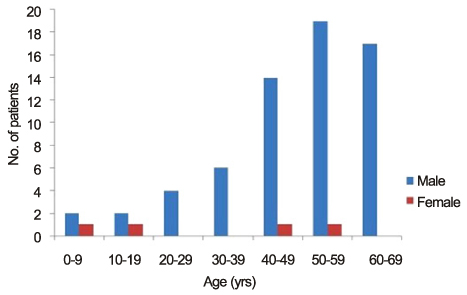J Korean Ophthalmol Soc.
2012 Nov;53(11):1564-1570.
A Statistical Observation of Corneal Laceration and Factors Influencing Visual Prognosis
- Affiliations
-
- 1Department of Ophthalmology, Chosun University School of Medicine, Gwangju, Korea. clearcornea@naver.com
Abstract
- PURPOSE
To investigate the regional characteristics and the factors that influence final visual acuity in corneal laceration and use the results for prevention and treatment of corneal laceration.
METHODS
Sixty-eight patients who visited the Chosun University Medical Center from January 1, 2006 to December 31, 2010 were retrospectively surveyed. The incidence of corneal laceration, sex, age, monthly and seasonal distribution, cause, site and length of corneal laceration, secondary operation, complications, and ocular trauma score were reviewed statistically. In additional, the factors influencing visual prognosis were investigated.
RESULTS
The incidence was more common in males (94.1%) and in the 6th-decade of life (29.4%). The corneal laceration was more common in the summer (38.2%) and in September (26.5%) and the most common cause was stone (39.7%) and metal (35.3%), respectively. The corneal laceration tended to occur at the corneal center. The most common first operation was primary closure (81.9%), and the secondary operation was most often performed due to a traumatic cataract (32.1%). The factors that significantly influenced the final visual acuity were initial visual acuity, length and site of laceration, and secondary operation.
CONCLUSIONS
The present survey investigated the regional characteristics and important factors influencing final visual acuity. Results show initial visual acuity, the length and site of laceration, and the secondary operation significantly influenced final visual acuity.
MeSH Terms
Figure
Reference
-
1. Kuhn F, Maisiak R, Mann L, et al. The Ocular Trauma Score (OTS). Ophthalmol Clin North Am. 2002. 15:163–165.2. Wurdermann . Injuries of the Eye. 1962. 2nd ed. St. Louis: CV Mosby;1–264. Part I.3. Pieramici DJ, MacCumber MW, Humayun MU, et al. Open-globe injury. Update on types of injuries and visual results. Ophthalmology. 1996. 103:1798–1803.4. Rhee HC, Chung SM, Rhea SW, Lee WC. Industrial ocular injary in St. Mary's industrial accident hospital. J Korean Ophthalmol Soc. 1989. 30:995–1001.5. Edmund J. The prognosis of perforating eye injuries. Acta Ophthalmol (Copenh). 1968. 46:1165–1174.6. Duke-Elder S. Injuries. System of Ophthalmology. 1972. Vol. 14. London: Henry Kimpton;574–576.7. Ahn JW, Moon SH, Lee DH, Lee CY. Factors influencing final visual acuity after penetrating ocular injuries. J Korean Ophthalmol Soc. 1998. 39:2451–2458.8. Han YS, Shyn KH. A statistical observation of the ocular injuries. J Korean Ophthalmol Soc. 2005. 46:117–124.9. Song MH, Kim JW, Chung SK. The statistical observation of ocular injury. J Korean Ophthalmol Soc. 2009. 50:580–587.10. Kim JH, Yang SJ, Kim DS, et al. Fourteen-year review of open globe injuries in an urban Korean population. J Trauma. 2007. 62:746–749.11. Chung SM, Choi JY. A clinical study of penetrating ocular injuries. J Korean Ophthalmol Soc. 1997. 38:491–498.12. Barr CC. Prognostic factors in corneoscleral lacerations. Arch Ophthalmol. 1983. 101:919–924.13. Hutton WL, Fuller DG. Factors influencing final visual results in severely injured eyes. Am J Ophthalmol. 1984. 97:715–722.14. Kim CW, Kim JM. Factors influencing the prognosis of corneoscleral laceration. J Korean Ophthalmol Soc. 1985. 26:311–319.15. Sternberg P Jr, de Juan E Jr, Michels RG, Auer C. Multivariate analysis of prognostic factors in penetrating ocular injuries. Am J Ophthalmol. 1984. 98:467–472.16. Kim JJ, Park BK, Lee SH, Oh SM. Ocular injuries, analytical view of 340 cases. J Korean Ophthalmol Soc. 1969. 10:27–31.17. Kim SY, Park JM. A Clinical Observation of corneal laceration with traumatic cataract. J Korean Ophthalmol Soc. 1995. 36:1694–1699.18. Yoo JH, Lee H, Lee J, et al. A statistical observation of ocular injuries and visual predictive value of ocular trauma score. J Korean Ophthalmol Soc. 2011. 52:1024–1029.
- Full Text Links
- Actions
-
Cited
- CITED
-
- Close
- Share
- Similar articles
-
- A Clinical Observation of Corneal Laceration with Traumatic Cataract
- Clinical Evaluation of Traumatic Cataract with Corneal Laceration
- Clinical Analysis of Traumatic Cataract with Corneal Laceration in Children
- A Case of Traumatic Complete Aniridia with Corneal Laceration
- A Clinical Study of Penetrating Ocular Injuries





